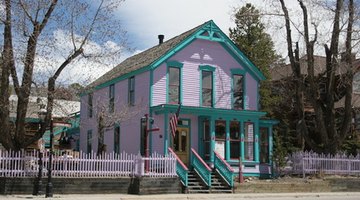Tennessee Building Codes for a Home Foundation
The foundation of a home is one of its most important structural elements. If the foundation is good, as the saying goes, then everything else will work out. Tennessee is one state that takes steps to ensure that a home foundation will “carry its weight” by applying adopted building codes to foundation construction.

Tennessee Foundation Codes
Tennessee adopted the 2003 International Residential Code (IRC) to be the overriding set of regulations for all structural aspects of home construction. The IRC has been adopted by many states as part of an integration of the other building codes specific to service systems (electrical, plumbing, etc.), and the codes that apply to foundations are found in Sections R401 and R403 of the IRC.
Section R401 covers basic home foundation aspects. Footers that extend through undisturbed soil must be dug 12 inches deep below the soil. Slabs that are laid on the ground using turndown footings (typical garage floor) require at least one line of #4 rebar at both the top and the bottom of the footing. Anchor bolts must be used in lieu of straps unless they are certified. Plastic sheeting (6 mil.) or sand must be used to protect footing in bedrock, and 6 mil. plastic must be installed as moisture barrier for slab foundations on the ground. (Reference 1)
Specific Home Foundation Codes
One- and two-family dwellings have become a focus of more recent building codes, and Tennessee has specific codes related to foundations in these types of homes. Title 12, Chapter 10, Section 12-2002 of the Franklin, Tennessee Code of Ordinances addresses foundation modifications for these dwellings. Footings that support a single-story home must be a minimum of 8 inches thick and 16 inches wide. Footings for two-story homes must be a minimum of 10 inches thick and 20 inches wide. Continuous footing systems are required in any case, and a minimum of two courses of ½-inch or greater rebar must be installed in those footings.
All foundation walls must be footed on concrete, except when a building official authorizes pre-engineered concrete foundations accompanied by foundation plans with load calculations signed and sealed by a licensed structural engineer. Wood foundations columns may not be used in crawl spaces when masonry blocks or other acceptable materials are applicable under the building codes. (Reference 2)
Pre-Cast Foundation Walls
In some cases, pre-cast concrete foundation walls are allowed to be used, as long as they are made and installed in compliance with the IBC. This type of home foundation must have certain properties to comply, including resistance to fire, heat, and moisture. Pre-cast walls are commonly used to support wood framing in homes, but they must be in compliance with Tennessee building codes for special conditions as well. Those cases where hydrostatic pressure is discovered during an underground water inspection require special waterproofing upgrades to the foundation walls.
Earthquake considerations are included in later Tennessee building codes, due to the potential for seismic activity in the New Madrid fault that runs through the state. Lateral-force resistance is applicable to foundation walls to allow for any seismic tremors that could cause a foundation wall to move sideways. The International Residential Code provides seismic categories for these applications. (Reference 3)
The Drip Cap
- The foundation of a home is one of its most important structural elements.
- If the foundation is good, as the saying goes, then everything else will work out.
- The IRC has been adopted by many states as part of an integration of the other building codes specific to service systems (electrical, plumbing, etc.
- ), Footings that support a single-story home must be a minimum of 8 inches thick and 16 inches wide.
- Pre-cast walls are commonly used to support wood framing in homes, but they must be in compliance with Tennessee building codes for special conditions as well.
- Lateral-force resistance is applicable to foundation walls to allow for any seismic tremors that could cause a foundation wall to move sideways.
References
Writer Bio
Greg Jackson is a transcriber, proofreader and editor. Jackson has been writing professionally since 1975, drawing on creative writing courses and personal experiences. His most outstanding work has been as an editor, proofreader and transcriber on two published books, "Douglas Fairbanks: In His Own Words" and "Bohemian Grove: Cult of Conspiracy."
Photo Credits
- house image by Earl Robbins from Fotolia.com
- house image by Earl Robbins from Fotolia.com
More Articles



